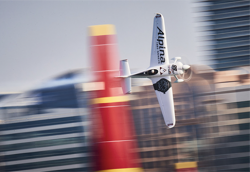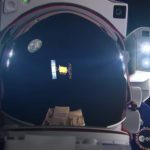 Horses racing by Margret Hofheinz-Doering 1956
Horses racing by Margret Hofheinz-Doering 1956Return to "GNSS Year in Review"
We’ve come a long ways from the attitudes of the Cold War environment in which the Global Positioning System and GLONASS programs arose.
But that doesn’t mean that GNSS competition is a thing of the past. Indeed, the second most-read item on the Inside GNSS website during this year was a March 2009 article entired “GPS, GLONASS, Galileo, Compass: What GNSS Race? What Competition?”
Return to "GNSS Year in Review"
We’ve come a long ways from the attitudes of the Cold War environment in which the Global Positioning System and GLONASS programs arose.
But that doesn’t mean that GNSS competition is a thing of the past. Indeed, the second most-read item on the Inside GNSS website during this year was a March 2009 article entired “GPS, GLONASS, Galileo, Compass: What GNSS Race? What Competition?”
Prestige may be a part of it, but more substantive issues drive the race for GNSS space. These include building national or regional technical expertise (and jobs), support for domestic manufacturers and service providers, and securing a place in the RF spectrum before the rapidly growing number of GNSS signals raise the noise floor to the point of interference and possible scrutiny by policy makers.
The past year produced a good deal of drama (such as the dismissal of Russian space officials following a failed launch), mystery (the still unpublished interface control document for Compass and specifications for Russia’s CDMA signal/frequency plan), and frustration (repeated delays is launching the first GPS Block IIF satellite and Europe’s postponement of its first launch of fully operational Galileo spacecraft).
With that in mind, here’s how the various programs did in 2010.
Compass/BeiDou-2
China was the latest — but not necessarily the last — nation to join the GNSS party with their announcement three years ago that it intended to expand a regional system based on earlier-generation technology into a full-fledged global system, BeiDou-2, also known as Compass.
In 2010, the program made up a lot of ground by launching five Compass satellites, which brought the BeiDou-2 constellation up to a total of seven. These included the system’s second geostationary Earth orbit (GEO) satellite launched January 17, another GEO on June 2, the first Compass inclined geosynchronous orbit (IGSO) satellite sent up on August 1, the fourth GEO on November 1, and a second IGSO in December.
Despite some indications over the past year that the China Satellite Navigation Program Office would publicly release a draft ICD reportedly completed in English- and Chinese-language versions, this key technical document remains unavailable except for a few Chinese manufacturers and agencies.
The BeiDou-2 program has, however, released details on its two-phase signal and frequency plans and appears to be on course to meet goal of having a regional system with 12 (or more) satellites in place by 2012 and the full system operating by 2020.
Global Positioning System
In discussing the relative position and progress of the United States in the GNSS race, we have to remember that the Global Positioning System has essentially lapped the field already. That is to say, GPS reached full operational capability (FOC) 15 years ago and currently has 31 operational satellites in orbit against a baseline constellation requirement of 24, plus some older satellites that can be reactivated if needed.
In that context, the launch of a single GPS satellite in 2010 could be misleading. Despite being several years late and undergoing four delays on the launch pad, the Block IIF space vehicle placed in orbit May 27 was the first of a new generation of GPS spacecraft.
Declared operational on August 27, early analysis of its new-technology rubidium atomic clocks indicates that they are near the accuracy and stability of the passive hydrogen maser on board the second Galileo In-Orbit Validation Element (GIOVE-B) satellite — which makes the IIF the best-performing timing system in space.
Meanwhile, work on the next-generation operational control segment (OCX) and space segment (GPS III) is well underway.
The Lockheed-led team designing and building the GPS IIIA spacecraft passed a critical design review in August and moved into the build phase ahead of schedule. Then, in September, Raytheon Corporation, which leads the OCX team, completed a crucial milestone — the integrated baseline review — on schedule.
Also last summer, the U.S. Air Force program office responsible for GPS gained a new commander, Col. Bernard Gruber, reorganized itself as a directorate (replacing the GPS Wing status), released three new GPS specification documents for L5 and L1C signals and the Block IIIA satellite, and celebrated the 20th birthday of a still-healthy GPS Block IIA satellite, the longest-lived in the program’s history.
GLONASS
Although some observers might argue that the Russian program had stumbled in the home stretch with a rare launch failure on December 5, the progress of GLONASS during 2010 reflects the fact that building a GNSS system is a marathon, not a sprint.
Since former president (and current prime minister) Vladimir Putin issued a May 2001 decree setting out a 10-year plan to rebuild and modernize GLONASS, the Russian program has grown from a feeble collection of seven aging spacecraft to a near-complete constellation of modernized spacecraft.
The year saw a steady stream of government announcements promoting GLONASS in domestic applications and releases of new receiver products combining the system with GPS. At year end, Russian company Sistema showed a working model of its first smart phone incorporating a GLONASS receiver using a Qualcomm GPS/GLONASS cchip and announcedthat the device would be available in quantity by the second quarter of 2011 at a cost of about $360.
Putin’s successor, Dmitry Medvedev, fired two high-ranking officials for mistakes made in the latest launch attempt, and Russia put off plans to launch the first demonstration GLONASS-K satellite until next year. Before that, however, Russia had brought six more satellites on line during 2010, with launches of three satellites on March 1 (completing a launch postponed from September 2009) and three more in September.
The GLONASS program also confirmed plans to add eight CDMA signals on four GLONASS frequencies over the next decade, beginning with the GLONASS-K.
Galileo
The European program got the year off to a strong start by awarding major contracts for satellites, launch services, and support services.
Trouble soon appeared, however, in official acknowledgement that budgetary and technical problems would delay implementation of the Galileo ground and space segment beyond its most recent target of 2012 and provide only a partial constellation in that time frame.
Subsequently, the program publicized a series of accomplishments, including the April release of an updated and official Galileo Open Service Signal-In-Space Interface Control Document (OS SIS ICD), a GNSS applications action plan, and signing of a €194 million ($270.5 million) contract with SpaceOpal to provide space- and ground-based services to operate the Galileo constellation once it has been fully deployed.
A problem with monitoring station receivers that delayed inauguration of the European Geostationary Navigation Overlay Service (EGNOS) appears to have been solved and the year ended with a solid reaffirmation of support (but not necessarily additional funding) from the European Space Council.
Augmentation and Regional Systems
Initial attempts to add to GNSS capacity with new regional or augmentation systems produced mixed results in 2010.
Japan’s succeeded in launching the first spacecraft in its Quasi-Zenith Satellite System (QZSS), but India failed in efforts to place a GPS-Aided Geo-Augmented Navigation (GAGAN) satellite in orbit last April.

.jpg)




